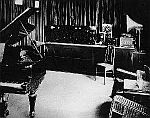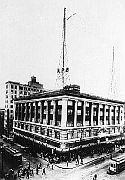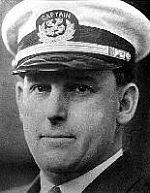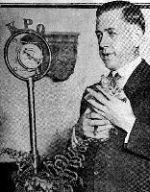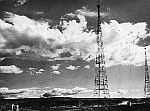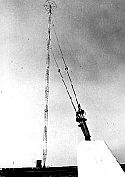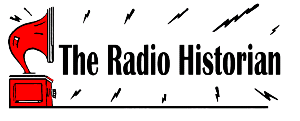
The History of KPO / KNBC / KNBR, San Francisco
By John Schneider, W9FGH
www.theradiohistorian.org
Copyright 1997 -
John F. Schneider & Associates, LLC
(Click on photos to enlarge)
The
KPO antenna on the
Hale Bros. Store.
KPO's 1,000 watt transmitter, 1925.
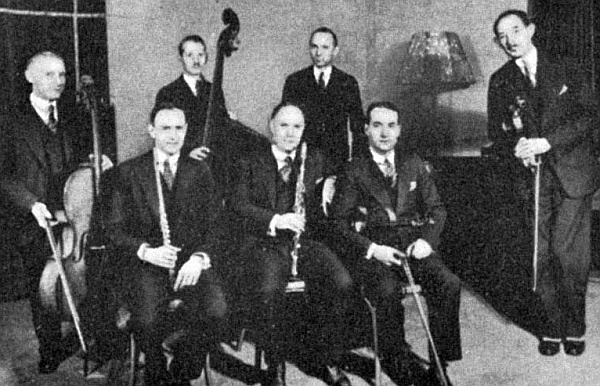
Cy Trobbe Orchestra
KPO's new
studios on the sixth floor of
Hale Brothers, 1925

The new Studio "A" at KPO, 1925
Lyle
Tucker, aka "Big Brother", KPO's first
children's program host, 1923.
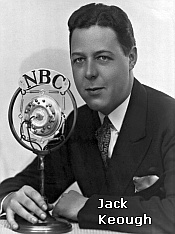
Jack Keough, one of KPO's first
sports announcers.
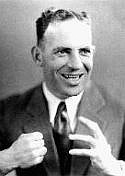
Ernie Smith, popular KPO sport announcer.
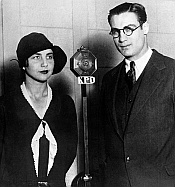
Don Thompson, one of many KPO personalities and performers.
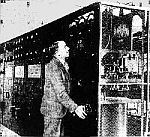
KPO installs a new 5,000 transmitter, 1929.
KPO's 50,000 watt antenna in Belmont.
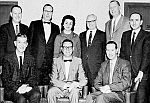
KNBC's Doug Pledger and staff, 1950s.
BEGINNINGS
KPO was a radio station that started small but was destined to become a giant. It all began in 1921, when Joe Martineau completed his tour of duty with the Navy and came back to San Francisco. He had done a lot of radio work in the Navy, and wanted to continue with it. So, he visited the Hale Brothers -- Francis, Marshall and Reuben -- owners of Hale Brothers' Department Store, one of San Francisco's largest. He proposed to them that they install an experimental broadcast transmitter in the store and allow him to operate it. They agreed, and KPO was built at a cost of just $2,400. It made its debut at 9 AM on April 17, 1922.KPO's programming them was explained in later years by Reuben Hale:
KPO was started on a shoestring. It was a small station, but with high ideals. No programs were permitted except that they were high class, and we were quite sure they would not offend the sensibilities of a mother with children in the home. Commercials were not allowed ...
KPO was on the air just one hour daily during its first year, sharing with other San Francisco stations the single broadcast frequency of 360 meters (833 kc.) Programs were usually from recordings, and consisted mainly of classical music or opera. Frequent live concerts featured local singers and pianists. In addition, when it could be arranged, national stars were heard. For example, Southern Pacific put up $2,500 to bring opera star Reinald Werrenrath from New York to San Francisco to sing over the Hale station.
KPO during these years was largely a one-room, one-man operation. The studio was on the sixth floor of the Hale Brothers store, and it contained a piano and a phonograph, as well as the fifty-watt home-brew transmitter and associated equipment.
Soon after KPO first went on the air, the Hales recognized the value of radio as a publicity agent for the store, and they determined to make it the best station in the area. Thus, KPO was "reborn" January 16, 1923, and came on the air this time as a Class "B", 500-watt station. The Class "B" license was a step above the former Class "A" license, and it required all programs to originate live from the studio. So, the Hales threw out their phonograph and began building a larger studio. Altogether, $60,000 was spent on refurbishing the station, quite an elaborate radio investment in 1923. The Western Electric 500-watt transmitter was mounted with its associated amplifiers and other equipment in what had been the original KPO studio, and a small room next door was converted to house the generators. A new and larger studio was constructed adjacent to these rooms, and a pipe organ was installed. Two 125-foot steel towers were erected on the roof of the building, and a four-wire T-type antenna was strung between them. The new super-powered KPO was on the air.
Joe Martineau became "Director" of the station, and a staff of several people was hired, including announcer Claire Morrison. The schedule was expanded to include several hours every Tuesday, Thursday and Saturday night.
KPO completed its remote hook-up to the Fairmont Hotel in May of 1923, and inaugurated it with an address by Secretary of War Weeks on May 25. Regular music programming from the Fairmont Hotel began two days later.
In May of 1923, the Department of Commerce broke up the logjam on 360 meters, and most stations were assigned to their own frequencies. KPO, as a Class "B" station, was given the preferred frequency of 710 kc. (The following year, KPO was moved to 700, and then back to 710 in 1926. Finally, in 1927, KPO moved to its permanent home of 680 kc.)
President Harding visited San Francisco in July of 1923, and KPO set up its equipment to pick up Harding's July 31st speech. A nation-wide hook-up was set up to send the speech eastward to five other stations, in what was to have been the first ever coast-to-coast broadcast. However, the broadcast never went on the air. Harding became ill while in San Francisco, and was taken to the Palace Hotel to rest. He died there August 2.
By the end of 1923, it was becoming obvious to the Hales that radio was more than a passing fad, and that it was proving to be an excellent public relations effort for their retailing organization. The Hales reaffirmed their commitment to make KPO a top-notch station.
With the help of the KPO engineering staff, remote broadcast equipment similar to that already set up at the Fairmont Hotel was installed at several other points in the city, and many of KPO's nightly programs originated from outside the studios. In October of 1923, a remote station was installed in the Palace Hotel, where the music of Cy Trobbe's Orchestra originated. Trobbe later became KPO's Music Director. And, in March, 1925, additional remote facilities were set up at the States' Restaurant, Loew's Warfield Theater and the Cabiria Cafe. In addition, KPO operated a remote truck, which could be set up anywhere for remote broadcasts.
Mrs. Jean Campbell Crowe became Program Director in 1925. She was an accomplished pianist, and, along with violinist Trobbe and George Von Hagel on cello, she established the first KPO studio orchestra -- a trio. Trobbe, who at 75 was still very active in San Francisco music, remembered the KPO trio:
"We were just brought up there as extras, to fill in the time between programs ... we'd get ten dollars a show, and play about fifteen minutes. The policy of KPO was 'NO RECORDINGS' -- everything had to be live. So, we were kept pretty busy after a while."Regular programs were also supplied by Max Bradfield and his Versatile Band and Rudy Seiger's Orchestra, both originating from the Fairmont. After KPO broadcast the dedication ceremonies of the California Palace of the Legion of Honor on January 11, 1925, this became yet another regular remote broadcast location, and Marshall W. Giselman broadcast organ recitals every Sunday afternoon.
KPO JOINS WITH THE CHRONICLE
Perhaps the biggest day of all for early KPO was March 4, 1925. On this date, it was announced that the "San Francisco Chronicle", whose new building was just around the corner from Hales, would join with the store in the operation of KPO. On that date, the station began announcing what was to become a trademark: "This is KPO -- Hale Brothers and the Chronicle". Also on that date, KPO became a part of the first coast-to-coast network broadcast: the inauguration of President Calvin Coolidge. KPO was the westernmost link of a transcontinental telephone line connected to 27 other stations across the nation. The broadcast had been arranged by RCA, a company that would be going into the network business on a full-time basis just eight months later, forming the National Broadcasting Company.Beginning in August, the station began calling itself "The Greater KPO", for it was now broadcasting with 1,000 watts from remodeled and enlarged studios. This new operations center reflected what was then the ultimate in radio facilities. The station now had ten rooms on the sixth floor of Hales, which included two studios, a control room, transmitter room, generator room, offices and a reception area. The main studio was large enough to hold a 90-piece orchestra, and also held the KPO studio organ. A second, smaller studio was built primarily for ensemble groups. Each studio had a special "announcer's post" in the corner. This was a desk where the announcer would sit in front of his microphone and control all studio mikes from a panel in front of him. This was unique to KPO at the time, but would later be utilized by the networks.
Another broadcasting landmark was set by KPO in November of 1925, when it became the world's first station to transmit a picture by facsimile. It was a picture of comic strip character Andy Gump, and it was signed by Chronicle publisher George T. Cameron, along with the words "Radio's latest wonder -- pictures through the air. What new marvels will this science bring forth?" Although it never materialized, it was thought for many years that radio facsimile would someday be utilized to transmit newspapers directly to the homes of their subscribers.
KPO became part of a two-station network in January, 1926, when it was connected with KFI in Los Angeles. Regular programs were exchanged frequently. Four more stations were added to the network the following year as the Western Division of the National Broadcasting Company was formed. Programs being heard in the East Coast over the NBC Red and Blue Networks were recreated by the NBC staff in San Francisco and heard over the NBC "Orange Network". (see separate document on the early West Coast networks.)
EARLY KPO PERSONALITIES:
By this time, KPO's programs were beginning to take on the polished "produced" sound radio would acquire in later years. KPO was the home of many local personalities that later went on to become big names across the nation in the thirties. One such person was Hugh Barrett Dobbs, known as "Dobbsie". Dobbsie had arrived in California from Annapolis in 1924, and worked as an athletic instructor in Oakland. The following year, he began a physical fitness program on KPO. His air personality soon earned him a better position, however, and the "Ship of Joy" program was born. Dobbs had a way with words, and his voice fairly dripped with sincerity, whether or not it was genuine. This ability qualified him as a top-notch radio salesman, when commercials first started to be heard, and his program soon became the "Shell Ship of Joy", after sponsor Shell Oil Company. Dobbsie became one of the area's top radio entertainers, and he was certainly one of the few radio personalities of his time to be earning $80,000 annually.
Dobbsie's hollow sincerity served to get him into a few tight spots. Early one morning, after a particularly fervent campaign he had started against reckless driving, he was arrested for speeding. He spent the rest of that night in a Marin County jail, rather than pay the fine and admit his guilt.
There were other KPO personalities well-known to the local radio audience: Jolly Bennie Walker and his "Women's Magazine of the Air" began on KPO and later moved to NBC. And, there was the well-known "Big Brother", host of a popular KPO children's program. Lyle R. Tucker was the original Big Brother, whose program began in 1925.
The Big Brother program was the typical children's program of the era, and consisted of what the Chronicle described as "stories, educational chats and answers to the questions of his little listeners". Children were encouraged to write to Big Brother, and he would print their letters in his daily column in the Chronicle, as well as answer their questions over the air. All children who wrote in were sent a red, white and blue Big Brother button, and automatically became members of the "Big Brother Club". Tucker's philosophy in dealing with the children was similar to the approach of later successful children's programs: "I like to give the girls and boys what they like -- funny stories, their own letters, and a good story which will have a little educational value hidden among the fun so that they won't suspect they are being 'preached at'."
Tucker left KPO two years later to start a similar program at KTAB in Oakland. His replacement was Jack Keough, who would be a fixture on San Francisco radio for many years. It was while Jack was doing this program that a famous slip was supposedly made that gained him notoriety for years to come. According to the story, after finishing a particularly well-done program, he shut off the mike and told a fellow employee, "Well, I guess that'll hold the little bastards!" But, he had thrown the wrong switch, and the comment had gone out over the air.
Whether Keough actually made the famous blunder was never fully resolved. Bill Andrews, who was a close friend of Keough's and a fellow announcer at NBC, said that Keough told him the whole incident was just a back- fence rumor, started by a person who had heard him make the comment in the studio. However, Carl Christiensen, then a KPO engineer, had claimed to be the engineer on the air at the time. He said it did go on the air, although faint in volume and covered up by music. Regardless of its authenticity, the story followed Keough like a ghost for the rest of his career.
Keough was also KPO's sports announcer, well-known throughout the city for his colorful play-by-play reporting. He was also responsible for Don Thompson's start in sportscasting, as KYA's sports announcer Ernie Smith once recalled:
... (Keough's) misfortune was to fail to show up in 1928 for a Shrine East-West football broadcast, because New Year's Day was too soon after New Year's Eve. Don Thompson, who was to have been his spotter, was pressed into service by a frantic oil advertising executive, Hal Deal -- and gave a great performance. Don's long career is, I hear, in its 42nd year as a producer for NBC in Hollywood.
Ernie Smith also had a long and successful career, as a sports announcer for the San Francisco Seals baseball team. He was San Francisco's third baseball announcer, following Claire Morrison and Jack Keough. He wrote of his beginnings as a baseball announcer:
Facilities for reportorial broadasting were naturally primitive. The Stanford booth was scarcely large enough for my spotter Mel Venter and me. I broadcast the first baseball game on the Pacific Coast from a make-shift aerie perched in the rafters of Kezar Pavilion, when Stanford and California played their first off-campus series as a dedication of that pavilion. Once I broadcast a Stanford-California game from a telephone booth on top of the Memorial Stadium press box.During the late twenties, Cy Trobbe was a popular musical figure at KPO. He conducted the studio orchestra and was the host of several popular music programs. One such program was the "Reo Masters of Music", sponsored by the Reo automobile. On this hour-long program, aired five nights a week, Trobbe promised to fulfill any song requests received in the mail. Another feature was "Cy Trobbe's Scrapbook". Years later, Trobbe recalled the purpose of this program:
I had enormous scrapbooks of anecdotes of musicians, composers, and all sorts of things, and I would read portions from these about such people as Beethoven or Mozart. Then we'd play some appropriate music to follow it. One time, I became very dramatic and I turned around to the mike and said, "Would you like to hear of the last hour of Chopin?" Some joker in the orchestra yelled "No!" After that, I was finished -- I broke up with laughter and couldn't go on.
EXPANSION:
In
1929, work was begun on KPO's third and biggest expansion project: the
increase to 5,000 watts. A new Western Electric transmitter was
purchased, and the studio complex was again enlarged, this time to the
point of using up all the existing floor space on the sixth floor. For
this reason, the transmitter was installed in the new nine-story Hale
Brothers annex building located across the alley. The old radio towers
atop the store were dismantled, and two new ones constructed -- one on
top of the store, and another atop the annex building. The larger
towers raised the antenna an additional fifty feet above the street
level, and situated it at a right angle to old antenna, which was
oriented it for better coverage up and down the coast.
A new Studio "B" was constructed, larger than its predecessor, and directly adjacent to the main control room. The old Studio "B" had been on the opposite end of the building, and this new location would enable both large and small studios to be operated from one control room. A new innovation just developed by the Western Electric laboratories, known as a master control panel, was installed in the KPO control room. This enabled the volumes of all studio microphones to be controlled separately and mixed together. This piece of equipment has since become the heart of any radio studio.
KPO continued to hold its reputation as one of the West Coast's most important stations through 1932. At that time, the station was leased to NBC, who later purchased it outright. The existing KPO operation was absorbed into the vast NBC-San Francisco complex, and the great station that was KPO became only a local relay for NBC programs, with few local shows and no staff of its own. It was to continue in this fashion throughout the thirties.
In 1933, KPO became the first station on the west coast outside of Los Angeles to increase its power to 50,000 watts. NBC constructed an elaborate transmitting complex on the salt flats of San Francisco Bay near Belmont. A spacious concrete transmitter building was constructed, and a huge General Electric transmitter was installed. The transmitter consisted of fifteen cabinets that were arranged in a U-formation around the main control desk. A spray pond was located outside the transmitter building, where the water used to cool the giant transmitter's tubes was cooled. The antenna consisted of two large self-supporting radio towers, with a single-wire T-type antenna suspended between the towers.
LATER YEARS:
NBC
changed the call letters of KPO to KNBC in 1947. In 1949 a new 550 foot
tower was constructed, replacing the longwire T-type antenna that had
been in use at the Belmont transmitter site since 1933. The new antenna
was of a unique design, similar to one recently constructed for WNBC in
New York. The improved system was designed to reduce fading in many
locations during evening reception, and resulted in better overall
signal performance. John Elwood, General Manager of KNBC, announced the
new tower had increased the station's prime coverage area by roughly
10,000 square miles.
In the 1950's, KNBC featured a mix of network programs and local record programs hosted by disk jockeys, including the popular Doug Pledger. This continued as the station's basic program offering into the 1970's and beyond, with popular later hosts such as Frank Dill and Carter B. Smith.
In the early 1960's, NBC wanted to move the KNBC call letters to its Los Angeles TV station KRCA, to commemorate their move from the Hollywood Radio City building to new studios in Burbank. As a result, the call letters of its San Francisco radio station were changed once again, this time from KNBC to KNBR.
KNBR made a short attempt at rock music programming in 1966. That was the year that a nationally-recognized programming expert studied the station and the San Francisco radio market. He declared that KNBR's sure-fire road to success would be Top 40 radio. NBC tried it for only six months, before discarding it as an utter failure.
KNBC operated from the NBC "Radio City" building at Taylor and O'Farrell Streets, virtually the only broadcast activity that took place at NBC's huge radio palace in the fifties and sixties. In 1967, KNBR was moved to studios in the Fox Plaza building.
In May of 1989, in the breakup of the NBC-owned radio stations, KNBR was sold to the Susquehanna Broadcasting Co.
REFERENCES:
"Scoop", published by the Press Club of San Francisco, 1970.
"San Francisco Examiner", January 14, 1923.
"Commercial Broadcasting Pioneer: The WEAF Experiment, 1922-26".
by Banning, William P.
"The Loudspeaker", KPO publicity newsletter, January 23, 1926.
Interview between author and Cyrus Trobbe, former KPO Music Director.
San Francisco, California, September 30, 1970.
"San Francisco Chronicle", January 16, 1925.
"San Francisco Chronicle", March 4, 1925.
"San Francisco Chronicle", August 3, 1925.
"Oakland Tribune", March 12, 1944.
Interview between author and Bill Andrews, former NBC announcer.
San Francisco, California, October 13, 1970.
"First Quarter Century of American Broadcasting", by E. P. J. Schurick.
"A Tower in Babel", by Eric Barnouw
The Federal Radio Commission station list, as authorized on 11/11/28.
From research by Barry Mishkind, 1993-94.
www.theradiohistorian.org
John F. Schneider & Associates, LLC
Copyright, 2015
